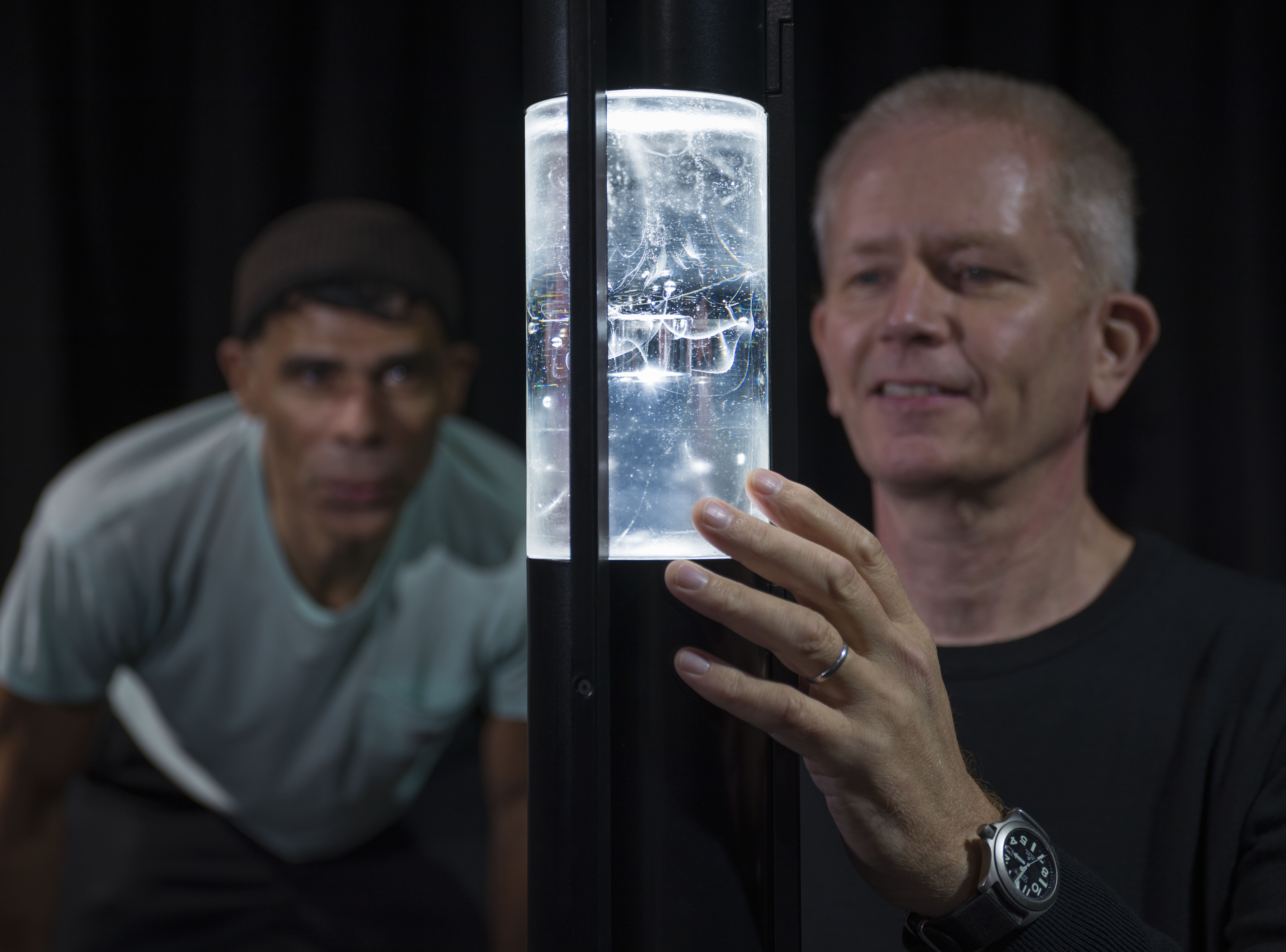Media release
From:
An exhibition featuring an Antarctic ice core and trapped air from 1765, is a warning from artists, scientists and engineers that the world needs to tackle global heating.
The artwork, Polar Zero, is a major exhibit at next week’s COP26 Glasgow climate summit and is the product of an unusual collaboration between artist and Royal College of Art PhD candidate Wayne Binitie, Arup engineer Graham Dodd and glaciologist Dr Robert Mulvaney from the British Antarctic Survey (BAS).
The centrepieces of Polar Zero are a cylindrical glass sculpture encasing Antarctic air from the year 1765 – the date scientists say predates the Industrial Revolution – and an Antarctic ice core containing trapped air bubbles that reveal a unique record of our past climate.
The air extracted from ice cores allows scientists to measure previous concentrations of gases, including carbon dioxide and methane, in the atmosphere and track how the Earth’s atmosphere has changed.
Polar Zero is the first time anyone has attempted the technical challenge of extracting ancient air from an ice core and encasing it within a glass sculpture.
1765 was selected as the year that human activity began to fundamentally accelerate the growth of greenhouse gases in the Earth’s atmosphere. In 1756 greenhouse gases made up 280 parts per million in the Earth’s air, today that figure sits closer to 415 per million.
Mr Binitie said it was his hope that people who experience his work “will gain a better understanding of humanity’s impact on the natural environment and its climate systems”. Mr Binitie formed a unique relationship with the BAS and Arup about five years ago. “Our collaboration involves artistic creativity, ice core science and advanced engineering,” he said, adding that he is keen to bring the exhibition to Australia.
Mr Dodd helped with the challenging tasks of releasing the trapped Antarctic air bubbles and melting the ice at just the right speed. “For the air, we settled on a glass casting with a hole from one end which would be filled with a fluid that bends light almost as much as glass does, so that it would not be obvious and only the cylindrical bubble would appear,” he explained.
“We found a clear sealant that would float on the fluid until it cured and became rubbery. Then Robert could turn the piece the other way up and inject the ancient air he had extracted, so that it forms a bubble on top of the fluid."
“For the ice core sculpture, we needed to calculate and construct the right amount of insulation needed to stop the ice from melting too fast, without needing refrigeration."
“As an artist, Wayne needed visitors to see, feel and hear the ice dripping away slowly. Arup's engineering input was to ensure the ice doesn't disappear too quickly and that both pieces are presented and lit in a way that the Antarctic ice, the melt water and the 256-year-old air are the artwork.” Mr Dodd added: "The stark contrast between the captured air within 1765 and the air popping out of the ice core, with the air that surrounds us now, conveys the impact of human activity on the earth’s atmosphere and the overwhelming need to take action now.” Polar Zero is the showcase artwork exhibited at the Glasgow summit in the Green Zone at the city’s Science Centre.
The ice core was donated by BAS to Mr Binitie, whose Polar Zero artwork has been funded by the Arts and Humanities Research Council, part of UK Research and Innovation.
Polar Zero gives visitors a unique vantage point into the Earth’s climate before and after industrial influence.
As the exhibit’s ice melts over the course of the climate summit, world leaders will see the real time effects of the changing climate. Mr Binitie hopes some of COP26’s VIPs will visit the exhibit.
“I want to do something to encourage a collective conversation: if we move forward collectively we know we can achieve a lot,” Mr Binitie said.
Arup is ensuring Australians have the opportunity to learn more about Polar Zero. To coincide with COP26’s Science and Innovation Day on 9 November from 6pm-7pm, Arup is hosting a live-streamed conversation with the artist, engineers and scientists who created Polar Zero, with some speaking live from COP26.
A global exclusive for Arup, Art, Science and The Race To Zero will feature Mr Binitie; Arup’s Global Sustainable Development Leader, Dame Jo da Silva; Mr Dodd; Dr Mulvaney and the curator of the Powerhouse Museum’s 100 Conversations, Catherine Polcz. The event will be moderated by multi-award-winning STEM journalist Rae Johnston.
In February 2022, 100 Conversations will engage leading Australian innovators fighting climate change, including Roger Swinbourne, Arup’s Australasia Sustainability Lead. The filmed conversations will create a publicly available archive of knowledge from Australia’s leading thinkers on climate.
Ms Polcz said: “We started 100 Conversations on the back of the devastating bushfires in Australia, and it seems like every month we’ve been working on it, something new happens.
“100 Conversations and Polar Zero both act like time capsules, with people in the future able to see where we went wrong in the past. The works act as a bridge connecting scientists to audiences and expand the ways in which we talk about climate change.”
Art, Science and the Race to Zero will also focus on one of COP26’s key priorities – collaboration – and in this case how organisations like Arup can partner with the arts community to fight the climate emergency in Australia.
Multimedia






 Australia
Australia


